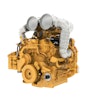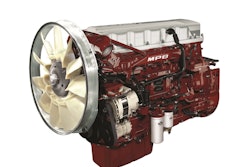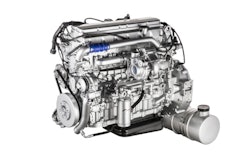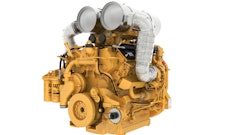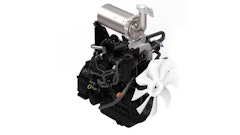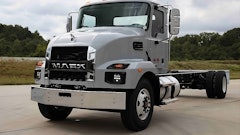
By now, most are familiar with biodiesel. It is a cost-effective and more environmentally friendly alternative to conventional petroleum-based diesel fuels when used in the correct applications.
“Biodiesel improves lubricity when compared to Ultra Low Sulfur Diesel (ULSD),” says Kaleb Little, senior communications manager, National Biodiesel Board. It also reduces emissions of hydrocarbons, particulate matter and carbon dioxide.
However, there are limitations when compared to petroleum-based diesel. Biodiesel typically has a higher cloud point, which means it may not perform well in low temperatures unless blended with traditional petroleum-based diesel; it has a tendency to absorb more moisture; and it typically produces slightly less power and fuel economy when used in higher blends.
It is also chemically distinct from petroleum diesel and has a separate ASTM standard. “Biodiesel must meet the ASTM D6751, its own separate ASTM standard that was developed back in 2002,” says Little.
Biodiesel comes blended with petroleum diesel fuel in various ratios, from B5, which is 95% petroleum diesel and 5% biodiesel, all the way up to B100, which is pure biodiesel. Engine manufacturers often publish the maximum content of biodiesel recommended, such as B10 or B20.
“Notably, all of the Big Three auto makers — Ford, General Motors and Fiat Chrysler — have supported high biodiesel blends for nearly a decade,” says Little. “Among U.S. heavy-duty truck segments, which account for more than 87% of actual diesel fuel usage, every major engine manufacturer has a recommendation in their owners’ manuals for B20 or higher, except for Daimler’s Detroit Diesel. Vehicle manufacturers don’t warranty fuel, rather just their own parts and workmanship.”
Perhaps the biggest hurdle for biodiesel is the availability of feedstocks to produce it. It is typically made from oils and fats such as soybean oil or used cooking oil, with soybean oil the most common feedstock. These sources are simply not capable of producing enough quantity to completely replace petroleum-based diesel.
The inherent limitations of biodiesel could soon be addressed by an emerging fuel source known as renewable diesel. “Renewable diesel is a drop-in fuel,” says Joanne Ivancic, Advanced Biofuels USA. “It can replace petroleum diesel completely. Also, it has no sulfur and has other properties that make it better than petroleum-based diesel.”
“Biodiesel and renewable hydrocarbon diesel fuel offer higher cetane numbers than traditional petroleum diesel for better combustion,” notes Little. “They also both dramatically reduce life-cycle carbon emissions.
“Like biodiesel, renewable diesel helps address the over-the-road and heavy-duty challenges,” he continues. “Some alternative fuels are optimized for centrally fueled fleets — those with short range or those with less need for pulling power. Diesel alternatives work in existing diesel infrastructure and engines and give users the flexibility to use what is readily available. They are the only solutions that are proven to work in heavy hauling, long-distance capacities.”
But understanding and acceptance of renewable diesel is still in the early stages. “While biodiesel has been produced in the U.S. for more than a decade, renewable hydrocarbon diesel is relatively new to the market in commercial volumes,” says Little, “so there have been fewer statements from equipment manufacturers of support or caution.”
A New Alternative
There are many similarities between biodiesel and renewable diesel. “Renewable diesel is a bio-based fuel, derived from a variety of waste agricultural feedstocks, that meets the same standard as traditional petroleum diesel fuel yet substantially reduces carbon emissions with additional air quality benefits,” says Allen Schaeffer, Diesel Technology Forum. “Renewable diesel fuel can immediately improve the emissions performance of older diesel vehicles and equipment and enhance the already impressive emissions reduction of new technology diesel engines, without sacrificing power or performance, at a price competitive with traditional diesel fuel.”
Technical hurdles to the adoption of renewable diesel are minimal. “As renewable diesel fuel meets the same standard as traditional diesel fuel, fleets do not incur additional fuel infrastructure investments or [need to] modify vehicles to operate on that fuel,” says Schaeffer.
So what’s the difference between renewable diesel and biodiesel? “Biodiesel and renewable hydrocarbon diesel go through a different production process — transesterification for biodiesel and hydrogentation for renewable hydrocarbon diesel,” says Little. “Both work to take readily available fats and oils (recycled cooking oil, animal fats and soybean oil) and optimize them for today’s commercial diesel engines.”
Transesterfication is the process of removing esters from oil. The molecules in biodiesel are primarily Fatty Acid Methyl Esters (FAMEs).
Renewable diesel is often produced from a process called hydrotreating, which is already being utilized in today’s petroleum refineries. During this process, hydrogen replaces other atoms such as sulfur, oxygen and nitrogen and converts the oil’s triglyceride molecules into paraffinic hydrocarbons. The resulting renewable diesel reduces waste and by-products, yields a higher energy density and improves cold flow properties, according to the Diesel Technology Forum. This process also enhances the blended fuel storage and stability of the finished biofuel product.
But hydrotreating is only one method of producing renewable diesel. According to the Diesel Technology Forum, other methods under consideration for creating renewable diesel fuel include biomass-to-liquid (BTL) and thermal conversion process (TCP) technologies. The former converts biomass through high-temperature gasification into synthetic gas or “syngas” and then uses a Fischer-Tropsch process to catalytically convert the syngas to liquid fuel. TCP processing converts biomass or other carboneous material into a “bio-oil,” which is then refined into diesel-like fuel. Both BTL and TCP offer the potential to convert large volumes of cellulosic biomass into liquid fuels, but need further development and remain far from being economical for large-scale fuel production.
Renewable Performance
“While renewable diesel fuel is a bio-based fuel derived from similar feedstocks as biodiesel, a different chemical process is involved to yield a final product that has chemical properties nearly identical to petroleum diesel fuel,” says Schaeffer. “In fact, renewable diesel meets the same standard as petroleum diesel fuel, as defined by ASTM International (ASTM), allowing the fuel to be easily blended into petroleum diesel fuel.”
This is a key difference between biodiesel and renewable diesel. “Since biodiesel is chemically different from petroleum diesel fuel, it must be produced to a different standard,” says Schaeffer. “Engine manufacturers approve their engines to operate on certain blends of biodiesel. Since renewable diesel meets the same standard as petroleum diesel, diesel engines can operate 100% on renewable diesel fuel.”
But it is important to note that ASTM D975 actually does not address all considerations of using diesel fuel in engines. For example, renewable biofuels have different cetane (ignition) ratings, which means that the engine will ignite and burn these fuels differently. To ensure the best engine performance it is important that prospective users verify the use requirements with their engine manufacturers.
Volvo/Mack announced recently that their on-road engines are approved to operate on 100% renewable diesel fuel. Other engine manufacturers may also be testing engines to operate on renewable diesel fuel.
Renewable diesel has the potential to dramatically cut greenhouse gas emissions. “While renewable diesel fuel meets the same standard as petroleum diesel fuel, renewable diesel fuel is considered an advanced biofuel by the U.S. Environmental Protection Agency (EPA), capable of reducing carbon emissions by at least 50%,” says Schaeffer. “In fact, the carbon reduction of some renewable diesel fuels approaches 90%, depending upon the feedstock. The California Air Resources Board (CARB) has also determined that renewable diesel fuel yields air quality benefits that improve the emissions performance of older vehicles that may not use the latest emission control technologies.
“Renewable diesel comes with the added benefit of reducing emissions of oxides of nitrogen (NOx), an ozone-forming compound, and particulate matter (PM) or soot relative to petroleum diesel fuel,” he continues. “Equipment owners who have not made the transition to the latest generation of clean diesel equipment may demonstrate clean air benefits to communities when operating older equipment using renewable diesel fuel. Equipment owners operating the latest generation of clean diesel equipment using renewable diesel fuel will demonstrate even greater air quality benefits to communities.”
The existing infrastructure is compatible with renewable diesel. “For equipment owners, the benefit of renewable diesel fuel is the fact that the use of the fuel requires no modification to engines or other components owing to the fact that the fuel meets the same standard as petroleum diesel fuel,” says Schaeffer. “As renewable diesel has nearly the same chemical properties as traditional petroleum-based fuel, renewable diesel shares the same infrastructure as petroleum diesel fuel. No additional pipelines or fueling infrastructure is needed. Fuel retailers must post the renewable diesel content offered for sale at the pump. Fleets and equipment owners with their own fueling infrastructure would not be subject to this labeling requirement.”
Markets Emerge
Market demand ultimately will determine the success or failure of any alternative fuel. “The largest market for renewable diesel fuel is California, where a tax and regulatory system encourages low carbon liquid fuels,” says Schaeffer. “Renewable diesel has benefited given its significant carbon reduction capabilities. We have seen retail prices for renewable diesel in California hover around the price for traditional ULSD. Some larger fleets, more recently in the cities of San Francisco and Oakland, announced that their full commitment to use renewable diesel fuel will come at a price competitive with traditional diesel fuel.”
“Much of the renewable hydrocarbon diesel available today is imported from Singapore,” Little points out. “It is widely available along the West Coast and made cost competitive through incentive programs like California’s low carbon fuel standard. In the Midwest, in cities without easy access to foreign ports, and places without added incentives, importing fuel is not practical or cost competitive.”
This could change over time. “There are two U.S.-based renewable hydrocarbon diesel facilities, both in Louisiana,” says Little. “Diamond Green Diesel recently announced a plant expansion. And the REG facility is expected to resume production later this year. Domestic production remains optimal for fleets focused on big picture sustainability.”
The goal is to continue to gain market share. “Of course, biodiesel, renewable hydrocarbon diesel and other alternative fuels are becoming more mainstream every day,” says Little. “In 2015, U.S. consumers used more than 2 billion gal. of biodiesel and renewable hydrocarbon diesel, or more than 5% of the on-road diesel fuel market.”
Increased supply will be necessary to become a mainstream fuel source. “Cars and trucks in the U.S. consumed about 40 billion gal. of diesel last year,” says Schaeffer. By way of reference, 1.4 billion gal. of biodiesel were produced and renewable diesel fuel was a fraction of this level of production. However, interest in the fuel among fleets and equipment owners across the country could help encourage more availability for the product to meet growing demand.”
Currently, the West Coast is driving demand. “Interest in the fuel is growing and availability in the West Coast, and California in particular, is expanding given the economics and low-carbon fuel standards in California that encourage low carbon liquid fuels,” says Schaeffer. “The City of San Francisco announced at the end of 2015 that it is using 100% renewable diesel fuel in all of the diesel vehicles and equipment in the city’s fleet. Oakland is following its sister city across the bay, while New York City announced that it intends to operate its enormous fleet on renewable diesel when the fuel is available on the East Coast. Still yet, UPS announced that it will purchase 46 million gal. of fuel for use in its fleet.”
Renewable diesel can be used as a strategy to achieve sustainability objectives. “Fleets and equipment owners who have chosen to switch to renewable diesel have done so as part of a low-cost strategy to meet sustainability goals,” notes Schaeffer. “Renewable diesel fuel can allow fleets to substantially reduce carbon emissions and petroleum use and improve air quality without sacrificing power, performance, driving range and other attributes, all at a price competitive with petroleum-based fuel.”
Switching from petroleum-based to renewable diesel in older machines could have a big impact on the environment. “For many states, expanded use of renewable diesel fuel in older in-use vehicles and equipment can provide air quality benefits,” says Schaeffer. “With interest in the fuel growing, we hope that availability expands, as well.”




